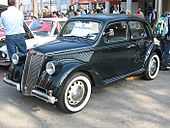Lancia Ardea
| Lancia Ardea | |
|---|---|
 | |
| Overview | |
| Manufacturer | Lancia |
| Production |
1939-1953 approx 32 000 vehicles |
| Body and chassis | |
| Body style |
4-door saloon truck (camioncino) van (furgoncino) taxi[1] |
| Layout | FR layout |
| Powertrain | |
| Engine |
903 cc Lancia V4 engine Max. Power output 26 bhp (19 kW) at 4600 rpm |
| Transmission |
4-speed manual 5-speed manual (3rd series 1948)[1] |
| Dimensions | |
| Wheelbase | 2,440 mm (96.1 in) |
| Length | 3,620 mm (142.5 in) |
| Width | 1,380 mm (54.3 in) |
| Curb weight | 800 kg (1,764 lb) |
| Chronology | |
| Predecessor | Lancia Augusta |
| Successor | Lancia Appia |
The Lancia Ardea was a small sedan produced by the Turin firm between 1939 and 1953. Its unusually short bonnet/hood reportedly contained the smallest V4 engine ever commercialized in an automobile.
Nearly 23,000 of the Ardeas produced were standard bodied sedans but between 1940 and 1942 approximately 500 Ardeas were manufactured with lengthened bodies and a squared off rear cabin for use in Rome as taxis. After the war more than 8,500 commercial adaptations of the Ardea known as 'furgoncini' (light van versions) and the 'camioncini' (car based light trucks) were also produced.
The third series Ardea, produced from 1948, was the first mass-produced car with a 5-speed manual transmission.[2]
Instrumentation included a centrally mounted speedometer, the fuel level and the oil pressure. A third dial directly below the driver's sight line was a clock, unusually on this size of car. The three floor pedals followed the pattern still 'conventional' for a manual transmission car (clutch, brake, gas) but to the left of the clutch pedal was a small foot operated dipper switch for the headlights. Control knobs lined up along the base of the fascia included a hand throttle.
Early Italian images of Ardea interiors confirm that Lancias of the period were still right hand drive, a position elsewhere taken to imply driving on the left side of the road. However, right-hand drive is practical even where drivers drive on the right-hand side of the road as it allows a better view of the edge of the road, which is useful when driving on rough roads in mountainous districts. This did mean that drivers of cars with centrally located floor mounted gear shifts, such as the Ardea, needed to learn how to shift with the left hand. During the 1920s Italian leader Benito Mussolini required all Italian drivers to drive on the right, but Lancia would continue, through the 1950s, to supply right hand drive cars in areas viewed by other automakers as left hand drive markets.
Four versions of the Ardea were built:
- 1st series, produced between 1939 and 1941, 2,992 built.
- 2nd series, produced between 1941 and 1948, 4,438 built. 12 Volt electric system introduced.
- 3rd series, produced between 1948 and 1949, 3,600 built. 5-speed gearbox introduced.
- 4th series, produced between 1949 and 1953, 11,700 built. New cylinderhead, aluminium, higher compression ratio, more power: 30 bhp.
Notes
- ↑ 1.0 1.1 "Lancia Ardea". carsfromitaly.net. Retrieved 2007-11-26.
- ↑ "Innovation by Lancia, Performance by Abarth". classicaldrives.com. Retrieved 2007-11-26.
- This article incorporates information from the revision as of 2008-02-19 of the equivalent article on the Italian Wikipedia.
| |||||||||||||||||||||||||||||||||||||||||||||||||||||||||||||
| « previous — Lancia Automobiles S.p.A., a subsidiary of the Fiat S.p.A. since 1969, car timeline, 1940s–1980s — next » | ||||||||||||||||||||||||||||||||||||||||
|---|---|---|---|---|---|---|---|---|---|---|---|---|---|---|---|---|---|---|---|---|---|---|---|---|---|---|---|---|---|---|---|---|---|---|---|---|---|---|---|---|
| Type | 1940s | 1950s | 1960s | 1970s | ||||||||||||||||||||||||||||||||||||
| 0 | 1 | 2 | 3 | 4 | 5 | 6 | 7 | 8 | 9 | 0 | 1 | 2 | 3 | 4 | 5 | 6 | 7 | 8 | 9 | 0 | 1 | 2 | 3 | 4 | 5 | 6 | 7 | 8 | 9 | 0 | 1 | 2 | 3 | 4 | 5 | 6 | 7 | 8 | 9 | |
| Small family car | …Ardea | Appia | Fulvia | |||||||||||||||||||||||||||||||||||||
| Large family car | …Aprilia | Flavia I | Beta | |||||||||||||||||||||||||||||||||||||
| Executive car | Aurelia | Flaminia | 2000 | Gamma | ||||||||||||||||||||||||||||||||||||
| Coupé | Fulvia Coupé / Sport | |||||||||||||||||||||||||||||||||||||||
| Flavia I/2000 | Beta Coupé / Spider / Montecarlo | |||||||||||||||||||||||||||||||||||||||
| Aurelia | Flaminia | Gamma Coupé | ||||||||||||||||||||||||||||||||||||||
| Sports car | Stratos | |||||||||||||||||||||||||||||||||||||||
| Racing car | D20 D23 D24 D25 | D50 | Montecarlo Turbo | |||||||||||||||||||||||||||||||||||||